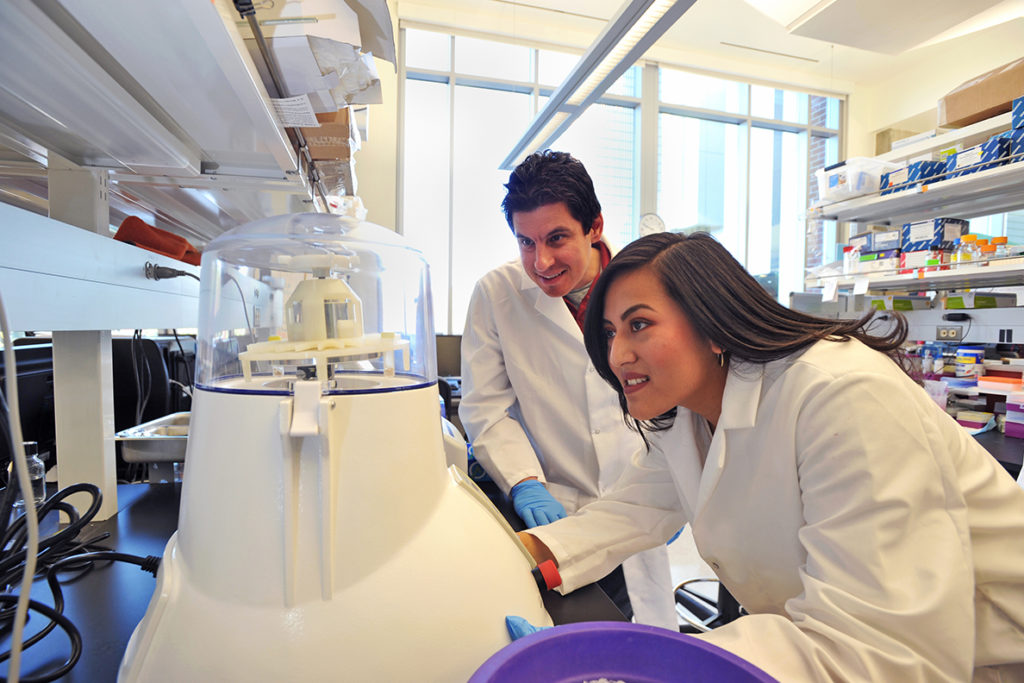Just a few short hours after illness-causing bacteria enter the human body, a sophisticated defense system goes to work. The immune system quickly recognizes the foreign invaders and sends a well-orchestrated, frontline defense.
“Innate immunity is ancient,” says Alan Goodman, assistant professor in the School of Molecular Biosciences and affiliate faculty in the Paul G. Allen School for Global Animal Health. “Our bodies have many ways of fighting infectious disease, but innate immunity is something that must be important for it to have persisted.”
Goodman and his colleagues found that one of those defenses, a protein called STING or stimulator of interferon genes, is also used by fruit flies, which are evolutionarily 800 million years older than humans. The STING protein signals to circulating blood cells to fight the infection in the body. Because both species use the same innate immune response, scientists can use the model to improve the human immune system and develop new ways to fight infection.
Healthy People and Animals
As a graduate student and postdoctoral fellow, Goodman primarily worked to understand viruses in humans. But once at WSU, he met researchers working on zoonotic diseases that transmitted from animals to people like Q fever, a highly contagious zoonotic disease caused by the bacteria Coxiella burnetii. Goats, sheep, and cattle are particularly susceptible to the disease, which can then be transmitted from animals to people. Although it is not usually fatal, Q fever causes flu‑like symptoms in people that can continue for years.
“I had never heard of Q fever before I came to the college,” says Goodman. A human disease researcher by training, Goodman is now applying his model with fruit flies to Q fever and undertaking a novel approach to understanding a disease that affects humans and animals. Once they know how the immune system is responding to the foreign invaders, they can use the knowledge to counteract the infection by priming the body’s immune response. “Our research can reduce infection in farm animals and in the human population,” says Goodman.
“One of the main reasons to study Q fever is because if there is an outbreak it can become very problematic,” says Goodman. “It can spread very rapidly, and the symptoms can linger for years. Antibiotics are not very effective against it because the bacteria can live in cells. If we understand the immune mechanisms, we can use that knowledge to reduce potential epidemics and to fight them off if they occur.”
Basic Scientific Research Leads to Breakthroughs
Goodman’s research, which is already helping to better understand how the innate immune system responds to disease, provides the basic science that can one day lead to ways to improve the human immune system and develop infection-fighting medicines.
Before receiving a $2.4 million federally funded grant from the National Institutes of Health in 2019, Goodman’s lab received intramural research seed money from the WSU College of Veterinary Medicine in 2016 and 2018 totaling $40,000. According to Goodman, that seed money was key for getting the federal award.
“We would have been much less competitive if we hadn’t received the seed money,” says Goodman. “Seed money allowed us to test preliminary hypotheses and to generate data. The results helped form more experimental models and let us know we were on the right track. And it helped us to do research for two key publications that show the kind of work we can do with fruit flies, Coxiella burnetii, and innate immunity.”
This article originally appeared in the College of Veterinary Medicine’s Advance newsletter. It is part of a series about how basic research is the foundation for medical innovation. Research conducted in neuroscience, microbiology, immunology, biochemistry, cell biology, and genetics provided the basis for developing medical technologies, therapies, and medication that can save human lives. Most basic science research is conducted at universities like WSU.






